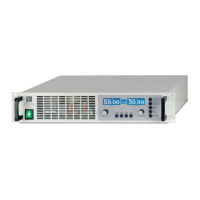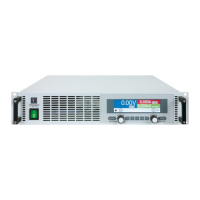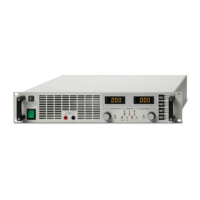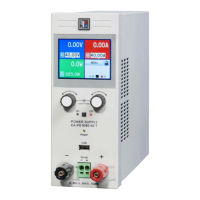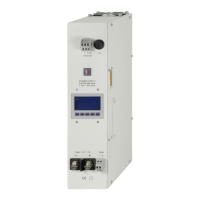34
© 2006, Elektro-Automatik GmbH & Co. KG
Irrtümer und Änderungen vorbehalten
EN
Instruction Manual
PS 8000 DT Series
Date: 02-09-2012
Operating the device
7. Device characteristics
7.1 Switching on by power switch
The power switch is located at the front. After switching on, the
device will show some information in the display: manufacturer‘s
name, address and logo, device type and rmware version. In
the device setup (see section
„8. Device setup“
) there is an option
„AutoPwrOn“ (auto power-on) that determines the output condi-
tion after the device is switched on. Default is „on“ and means,
that the set values of U, I, P, the values of OVP and UVL and
the output condition are restored to what was present when the
device was switched off the last time. In case the option is set
to „off“, the set values of U and I are set to 0, the set value of P
to 100%, OVP to max., UVL to min. and the output is switched
on after every start.
7.2 Switching off by power switch
Switching the device off by power switch is handled as mains
blackout. The device will save the last set values and output
condition. After a short time, power output and fans will be
switched off and after a few seconds more, the device will be
completely off.
7.3 Switching to remote control
a) Analogue interface: Pin „Remote“ switches the device to
remote control, if not inhibited by LOCAL mode or remote
control by digital interface already being active. The set values
pins VSEL, CSEL and PSEL (only required with models from
1kW), as well as REM-SB are then in command. The output
condition and the set values which are put into the pins are
immediately set. After return from remote control, the output
will be switched off.
b) Digital interface: Switching to remote control is done by
the corresponding command (here: object), if not inhibited by
LOCAL mode or remote control via analogue interface already
being active. It keeps output state and set values until altered.
Leaving remote control automatically switches the output off.
7.4 Overvoltage alarms
An overvoltage alarm can occur due to an internal defect (out-
put voltage rises uncontrolledly) or by a too high voltage from
external. The overvoltage protection (OVP) will switch off the
output and indicate the alarm on the display by the status text
„OV“ and on the pin „OVP“ of the analogue interface.
If the cause of the overvoltage is removed, the alarm has to be
acknowledged rst. In manual operation, it is done by pushing
button Output On/Off, in analogue remote control with pin
„REM-SB“ and in digital remote control by the corresponding
command. Then status text „OV“ and OVP signal will disappear.
If the alarm is still present, the output will not be switched on.
OV alarms are recorded into the internal alarm buffer. This buffer
can be read out via a digital interface, except those using SCPI
language. Reading the buffer will also acknowledge.
Note
The status of an OV alarm has priority over the status of an
OT alarm and will overwrite the status text „OT“ in case both
alarms occur the same time and are not yet acknowledged.
7.5 Overtemperature alarms
As soon as an overtemperature (OT) alarm occurs by internal
overheating, the output is switched off and the status text „OT“
is indicated. Simultaneously, the LED „Output On“ will ash,
indicating that the output will automatically switch on again as
soon as the device has cooled down. In case this is not wanted,
the output can be switched off manually. Then the LED stops
ashing and the output won‘t switch on automatically.
If the output is off after the device has cooled down, it can be
switched on again by using button Output On/Off or pin „REM-
SB“ or the corresponding command. If the output is on, pushing
button Output On/Off once or giving pin „REM-SB“ a high-to-low
toggle or using the corresponding command rst acknowledges
the alarm and then switches the output off.
OT alarms are recorded into the internal alarm buffer. This buffer
can be read out via a digital interface (except those using SCPI
language). Reading the buffer will also acknowledge.
Note
The status of an OT alarm has lower priority than an OV
alarm and the status text „OT“ will be overwritten by „OV“
in case both alarms occur the same time and are not yet
acknowledged.
7.6 Voltage, current and power regulation
The output voltage of the power supply and the resistance of
the load determine the output current. If this current is lower
than the current limitation set by the current set value, then the
device is working in constant voltage (CV) regulation, indicated
by the status text „CV“.
If the output current is limited by the current set value or by the
nominal current, the device will change to constant current (CC)
regulation mode, indicated by the status text „CC“.
Models from 1kW output power additionally feature an ad-
justable power limitation for 0...P
Nom
. It becomes active and
overrides constant voltage or constant current regulation mode,
if the product of actual current and actual voltage exceeds the
adjusted power limitation or nominal power of the device. The
power limitation primarily affects the output voltage. Because
voltage, current and power limitation affect each other, various
situations like these may occur:
Example 1: the device is in constant voltage regulation, then
the power is limited down. As a result, the output voltage is de-
creased. A lower output voltage results in a lower output current.
In case the resistance of the load is then decreased, the output
current will rise again and the output voltage will sink further.
Example 2: the device is in constant current regulation, the
output voltage is dened by the resistance of the load. Then
the power is limited down. Output voltage and current are
decreasing to values according to the formula P = U * I. If the
current set value is then decreased, the output current would
also decrease and thus the output voltage. The product of both
values, the actual power, would sink below the previously set
power limit and the device would change from constant power
regulation (CP) to constant current regulation (CC).

